With the curtain now drawn on the 2024 Women’s National Basketball Association (WNBA) season, it’s evident that the league has transformed itself into one of the most captivating sports platforms in the United States. Thanks primarily to the emergence of compelling young stars like Caitlin Clark and Angel Reese, the WNBA witnessed unprecedented viewership numbers and attendance records. This remarkable growth not only highlights the league’s potential but also raises questions about the future landscape and challenges that lie ahead.
The 2024 season marked a significant milestone for the WNBA, drawing in over 54 million unique viewers, a figure that reflects a striking trajectory of growth across various networks such as ABC, ESPN, CBS, and NBA TV, among others. This influx of viewers extends beyond casual fans; it illustrates a deepening cultural resonance of women’s basketball in mainstream sports. Attendance figures also surged, hitting the highest levels seen in 22 years, doubling from the previous season’s numbers and achieving 154 sellouts, more than triple that of the prior year.
The catalyst for this sudden increase in interest can be largely attributed to a mix of exciting gameplay and star power. The performances of rookies like Clark, who plays for the Indiana Fever, and Reese, of the Chicago Sky, stirred significant media buzz and drew crowds to arenas. Both players not only managed to fill seats but also captured the imaginations of fans by displaying exhilarating skills that rival their male counterparts. As these stars continue to shine, they are likely to attract new generations of fans, a critical factor for the league’s sustained growth.
Coinciding with this surge in popularity, the WNBA successfully negotiated a groundbreaking new media rights deal valued at $2.2 billion over 11 seasons. This deal comes after extensive negotiations with NBA executives, who recognize the WNBA’s rising status and worked to secure a profitable agreement. Often viewed as the “older sister” league, the NBA has now begun to champion the WNBA’s interests, which is an encouraging sign for the future trajectory of women’s sports.
Moreover, the league is gearing for expansion with plans to introduce a 15th team in Portland by 2026. This move speaks volumes about the increasing recognition of women’s sports as economically viable and culturally significant. Establishing more teams might not only enhance competition but also allow for broader geographical reach and further engage fans across the nation.
While the WNBA has reason to celebrate its accomplishments, it must also confront some uncomfortable realities. As the league’s visibility increases, so too does the likelihood of its athletes encountering online harassment and racism. This troubling trend has been publicly acknowledged, prompting Commissioner Cathy Engelbert to express opposition to such behavior. However, her initial reluctance to address the issue more robustly drew criticism from within the league.
This duality presents a challenge for the WNBA as it navigates a landscape that celebrates its progress but also exposes its players to hostility. The league must take a strong stance, not only to protect its athletes but also to encourage an inclusive atmosphere that reflects society’s broader efforts against discrimination.
The WNBA’s ascendant visibility is also reflected in the social media realm, achieving an astounding near 2 billion video views on its platforms—an increase that symbolizes a heightened fan engagement. This phenomenal uptick suggests that the league’s marketing strategies are resonating and that fans are eager to engage with their teams and players beyond the confines of the basketball court.
Additionally, merchandise sales have seen a sharp rise as eager support from fans translates directly to economic growth for teams. This momentum is pivotal for establishing sustainable financial foundations that can safeguard players’ futures and enhance community engagement.
The 2024 season marked a turning point for the WNBA, heralding a new era characterized by record-breaking viewership and attendance. While the league must navigate complexities surrounding harassment and racial issues, its substantial growth in popularity signals a bright future. The rise of younger stars, combined with strategic expansions and growing financial clout, may well position the WNBA as a cornerstone of American sports. As the league embraces its burgeoning success, the real measure of its triumph will lie in how it tackles the challenges that accompany such visibility and power.

Leave a Reply